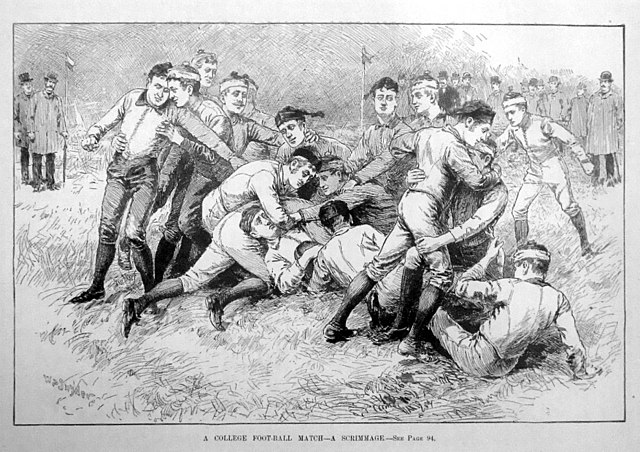In this edition we take a look back at some football history and evolution of the game we will chat a bit about how far the line to gain equipment and rules have come.
Measuring Up the Chains
Measuring up football equipment
Most fans watching football games on television only know the line to get a first down as a literal line drawn on the TV screen. It is, of course, as the announcers tell us repeatedly, not the official mark. The normally orange-colored giant bannered poles connected by a ten-foot-long chain are the official measurement tools. In the NFL, there is one set on each sideline, and the one on the side of the Head Linesman is the official one to indicate where the actual line to gain is; the other is just a mirror to be a point of reference.
The history of the line to gain has transformed more than most over the last century and a half.
In the beginning...
It was in the early 1880s when, at Walter Camp's suggestion, football placed a line to gain of 5 yards. There were few lines on the field at this time and not a crew of three or four people on the sideline with measuring equipment to monitor where the lead stick was. A representative judge from each team accompanied many times only a Referee to help enforce the rules. So how did they do it?
According to an interview with Coach John Heisman found in Frank Menke's "Encyclopedia of Sports" via Allison Danzig's book "Oh, How They Played the Game", it was stated that there were no five yard stripes going across the field. The statement goes on to say;
"There were no linesmen, and no line sticks. The Referee kept track of distance by just dropping a handkerchief where he guessed the ball as last put into play. The Players of both sides would slyly try to move that handkerchief, while some teammate engaged the referee in a discussion of the rules. So we varied action by kicking a handkerchief as well as a football."
This changed after what had to be a plethora of onfield issues and arguments over if a team got the first down or not, or hey, he kicked the hanky. Our friend, author Timothy P. Brown in his excellent book, How Football Became Football tells us that in 1898 the linesman's chain entered into the football rulebook. Brown tells us that;
"Initially, the chains were a simple set of poles connected by a chain or rope supplemented by a third pole, or down marker..."

Courtesy Wikimedia Commons of "A college Football match - a Scrimmage". Illustration from 1885. Notice the line to gain sticks in the background with a small flag atop each?
That sounds familiar, except they were very plain Jane and vanilla and difficult to see from across the field. Picture it in your head; the poles were probably just pieces of unpainted wood in many cases, maybe a gray-colored piece of pipe. They only indicated where the line to gain was and the ball's position.
Remember, the line-to-gain rules were that an offense had three downs to gain 5 yards through 1905. As part of the gridiron revisions before the 1906 season, spurned into action from a meeting with President Theodore Roosevelt, football rolled out the 10-yard line to gain. Six years later, in 1912, a fourth down was added for teams to try and reach the ten-yard increment in the United States.
Timothy Brown tells us, though, that it was in the 1920s when the poles became more ornate, and a numbered cube was added to the down marker that could tell everyone what down it was. The guy holding the boxed pole would turn the correct number down towards the field of play. That would be great if you were on the field, but your information could have been more accurate if you sat behind that sideline. The name of this ball position stick is still referred to as the "box" to this day, although innovations to flip chart style tops that would tell people all around the stadium what down it is soon followed. The Dial-A-Down marker, which is so common today, hit the market in the mid-1980s to take the down indicator to a new level.
In the Twenty-First century, as discussed earlier, we know we have the super-imposed line on the TV screen to help show where the offenses need to get to receive a new series of downs, but where can it go from here? There have already been thoughts, and even tests done to plant chips in the ball. These would give the ball's exact location at any point during a down and, when coupled with sideline data, could efficiently and accurately tell everyone when the first down marker was reached without much speculation. This, along with the human element and video, could help pinpoint where the ball is when the ball becomes dead. Then we can have fun arguing about calls that computers make.
Credits
The photo above is courtesy of Wikimedia Commons, taken by an unknown of U.S. Senator Bob Graham during workday as a member of the 2003 FedEx Orange Bowl chain crew at Pro-Player stadium.
Special thanks to Timothy P. Brown and his great book and website as well as author Allison D.





